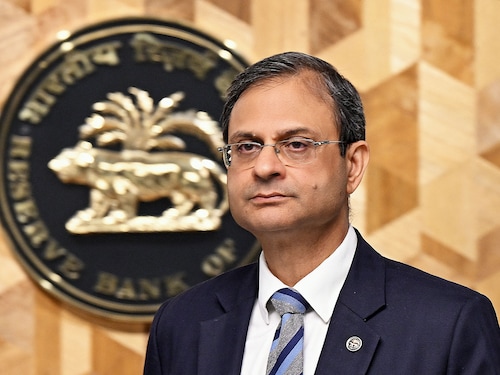RBI annual report: Indian economy in the fast lane
From inflation and growth to UPI, the central bank projects a promising outlook for the country, but cautions of sporadic volatility in financial markets


The Reserve Bank of India (RBI) is confident that India will retain its position as the world’s fastest-growing economy in the current fiscal and emerge relatively unscathed from the ongoing global macroeconomic storm.
“The Indian economy is poised to remain the fastest-growing major economy in FY26 by leveraging its sound macroeconomic fundamentals, robust financial sector and commitment towards sustainable growth," it said in its annual report released on Thursday.
However, the central bank fears that there could be sporadic episodes of volatility in financial markets. It advised lenders to build robust risk management frameworks to navigate global uncertainties such as rising geopolitical tensions and the progress of trade tariff policies.
The report also mentioned that the RBI plans to scale up digital rupee trials, integrate CBDC (central bank digital currency) with digital wallet platforms, and consider cross-border payments to boost international transactions and new use cases. It said it wants to introduce a framework for ethical adoption of artificial intelligence to support regulatory supervisory functions.
Here are the key takeaways from the 318-page annual report on how the domestic economy is likely to weather global turbulence and chart its growth trajectory in the coming months:
The RBI said the Indian economy will continue its growth momentum despite global headwinds largely on account of pickup in private consumption, healthy balance sheets of banks and corporates, easing financial conditions, and the government’s continued thrust on capital expenditure. It has projected real GDP growth for FY26 at 6.5 percent with risks evenly balanced.
The central bank expects the manufacturing sector to expand given the government’s focus on widening the manufacturing base through policy support with the ongoing PLI (production-linked incentive) scheme and National Manufacturing Mission to strengthen the ‘Make in India’ initiative.
It expects India’s export sector to remain resilient given its participation in 14 free trade agreements and six preferential trade agreements. “The new trade deals under negotiation with the US, Oman, Peru and the European Union may support growth in trade," it said. “Resilient services exports and inward remittances are likely to cushion current account deficit, which would remain eminently manageable in FY26."
Headline inflation fell to an average of 4.6 percent during FY25 from 5.4 percent in FY24. This was mainly due to moderation in core inflation. The RBI sees the downward trend in inflation to continue.
“The easing of supply chain pressures, softening of global commodity prices and higher agricultural production on the back of a likely above-normal Southwest monsoon augur well for the inflation outlook in FY26," it said in the annual report.
The sharp decline in food inflation in the last two months has given the RBI greater confidence about a durable alignment of headline inflation with the target of 4 percent over a 12-month horizon. “The benign inflation outlook and moderate growth warrant monetary policy to be growth supportive, while remaining watchful about the rapidly evolving global macroeconomic conditions," it noted.
The RBI reduced the repo rate by 50 basis points in the current calendar year, after maintaining status quo since February 2023 at 6.5 percent. It also changed its policy stance from withdrawal of accommodation to accommodative in its April monetary policy meeting. In the annual report, the central bank reiterated its commitment to boost growth since inflation is under control.
It also noted that the transmission of policy repo rate changes to banks’ deposit and lending rates remained robust during FY25. “The proportion of external benchmark-linked loans in total outstanding floating rate loans increased further during the year, with concomitant fall in marginal cost of funds-based lending-rate-linked loans," it added.
As per the annual report, liquidity conditions improved in FY25 in comparison to the previous year. However, during the year, system liquidity moved from surplus during July-November 2014 to deficit during December 2024-March 2025. This was largely due to capital outflows and advance tax payments.
“The Reserve Bank will continue to undertake liquidity management operations in sync with the monetary policy stance to keep system liquidity adequate to meet the productive requirements of the economy," it highlighted in the report. “It will deploy an appropriate mix of instruments to modulate frictional as well as durable liquidity, ensuring orderly movement of money market interest rates."
The RBI annual report says total digital payments grew by nearly 35 percent and 18 percent in volume and value terms each during FY25. Also, Unified Payments Interface (UPI) placed India in a leadership position with a share of 48.5 percent in global real-time payments by volume, the annual report stated.
“The Reserve Bank continued to chart the course laid down in the Payments Vision 2025 document and under the ‘Inclusion Pillar’, ‘Delegated Payments’ was introduced to deepen the reach and usage of digital payments," the central bank elaborated. “Regulatory efforts also took centre stage on strengthening fraud reporting mechanisms and encouraging information security preparedness, with an emphasis on cyber resilience."
The annual report states that the central bank’s FY25 balance sheet increased by 8.2 percent to Rs76.25 lakh crore versus Rs70.47 lakh crore in the previous year. During the period there was a 22.7 percent rise in income and a 7.7 percent rise in expenditure. There was a surplus of Rs2.68 lakh crore in comparison to Rs2.1 lakh crore in FY24.
The higher surplus was used for a record dividend payout of Rs2.69 lakh crore to the government. This was lower than Street expectations though.
The increase in assets was mainly due to a rise in gold, domestic and foreign investments by 52 percent, 14 percent, and 1.7 percent respectively. Liabilities rose due to a 6 percent increase in notes issued. Other liabilities increased by over 23 percent.
First Published: May 29, 2025, 17:10
Subscribe Now